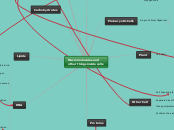Macromolecules and
other things inside cells
Water
Can exist in different states of matter
Connected by hydrogen bonds
Chemical Formula: H2O
Hydrogen ions
Oxygen Ions
Prokaryotic Cells
Single Cellular Organism
Can have flagellum or cilia
Ex. Bacteria
Do not have a membrane bound nucleus
May contain extra DNA in plasmids
Plant
Cell Wall
Organelles different from Animal cell include:
Choloroplasts
Granum
Thylakoid
Stroma
Double Membrane
Cell Wall
Other Cell
Cell Signaling through membranes
Sends out signals to other cells to make proteins amongst other thngs
Separated by different junctions
Transport proteins
Contains the same DNA of all of the other cells
Proteins
Cell
Cell Division
Mitosis
Forms two diploid cells
Makes somatic cells
Meiosis
Forms four haploid cells
Makes gametes
Organelles
Cytoplasm
Endoplasmic Reticulum
Nucelus
Golgi Apparatus
Vacuoles
Mitochondria
Powerhouse of the cells
provides energy for the cell for processes
contains own DNA
Ribosomes
Protein Synthesis
Extracellular matrix
Subtopic
Phosphlipid Bilayer
Hydrophillic (water loving) head
Hydrophobic (water repelling) tails
Carbohydrates
Lipids
DNA
Stands for: Deoxyribose Nucleic Acid
Made of nucleotides joined together by hydrogen bonds
Nucleotides include Adenine, Thymine, Cytosine, and Guanine
Can be seen in the form of Chromosomes
Nucleosomes and histones are responsible for giving chromosomes their curly shape; they increase the surface area
Replication
Mitosis
DNA to DNA
Needs certain polymerases, an origin of replicaton, replication fork, etc.
Translation
mRNA to protein
Produces Proteins
A set of 3 codons codes for one protein
Codon table. More than one codon sequences can make the same protein
Transcription
DNA to mRNA
